Get PeakVisor App
Sign In
Search by GPS coordinates
- Latitude
- ° ' ''
- Longitude
- ° ' ''
- Units of Length

Yes
Cancel
Share ×

Scan the QR code and open PeakVisor on your phone
❤ Wishlist ×
Choose
Delete
Situated on the northern peninsula of Taiwan is Linshanbi Nature Reserve (麟山鼻自然保護區). Known for its incredible biodiversity, it’s also well-known for its golden sandy bays. There is only one named mountain in this area, Xiayuankengshan (下員坑山), measuring 33 meters (108 ft).
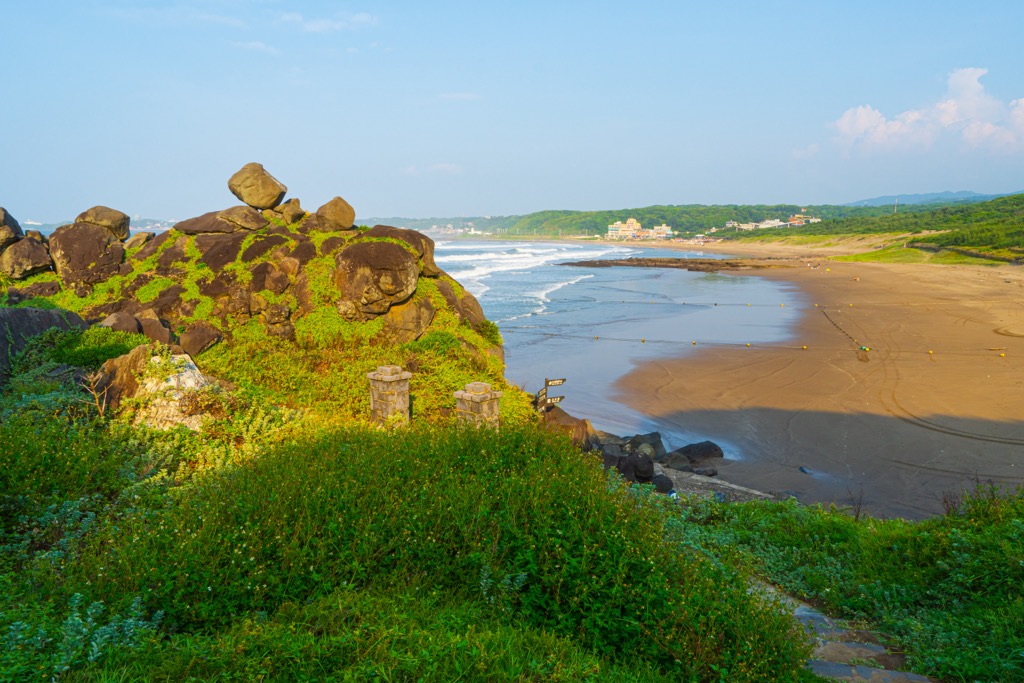
Linshanbi Nature Reserve lies on the northern coast of New Taipei City’s (新北市) Shimen District (石門區). This small stretch of shoreline lies in the North Coast Coastal Reserve (北海岸沿海保護區), stretching from northwestern Sanzhi (三芝區) to northeastern Jinshan (金山區) districts.
Linshanbi’s peninsula was named “Linshan Nose” during the Japanese Occupation Era, as its headland resembles a pointy snout. The name has stuck since, and it's now known as one of Taiwan’s most beautiful peninsulas.
The rocky shores are evidence of northern Taiwan’s volcanic past when the Datun Volcano Group (大屯火山群) erupted in periodic blasts between 200,000 to 1 million years ago. Nearby, Zhuzhishan’s (竹子山) lava flowed towards the cape, spilling onto Linshanbi and Fugui’s shores. Thus, andesite comprises the rock, forming algal reefs interbedded with lime mud.
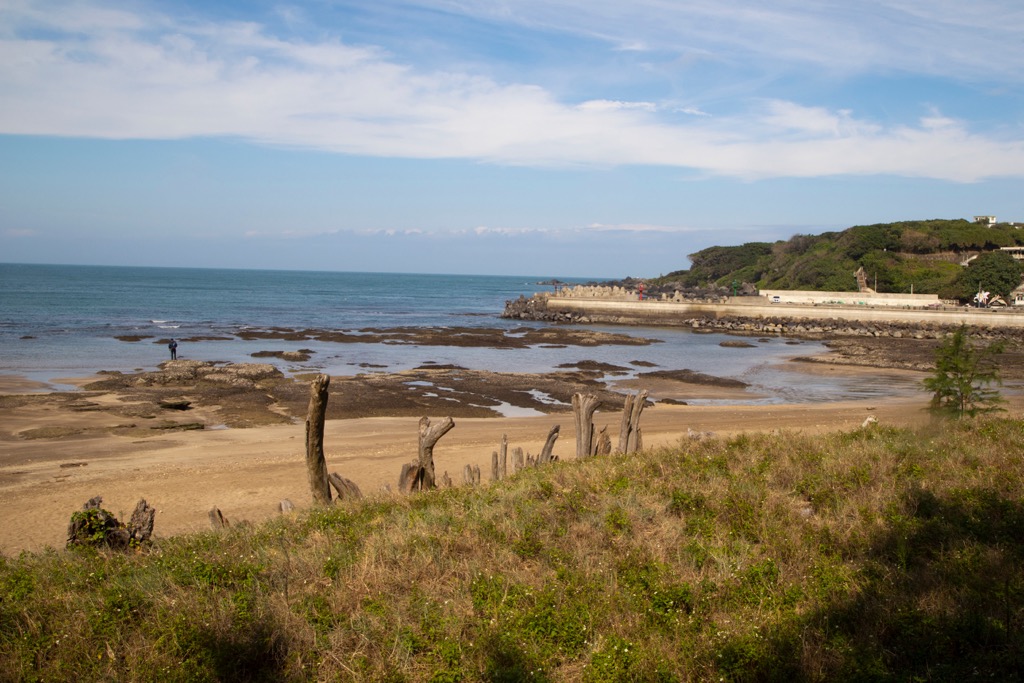
As Linshanbi Nature Reserve runs along the north coast, the intense sea winds and fierce waves erode the shoreline’s rocks into strange formations. These creations are ventifacts, which are pointed rocks sculpted from the sea air.
While the reserve is rather small, alluring nature surrounds Linshanbi. To the north is the South China Sea (南中國海), while Taipei’s (臺北市) backyard, Yangmingshan National Park (陽明山國家公園), is in the south. The fascinating Laomei Green Reef (老梅綠石槽) is in the east, while Tamsui’s (淡水區) river port is west.
A total of 20 northern Taiwan peaks belong to the Datun Volcano Group. These stretch in a band between Taipei and New Taipei City. The closest coastal peak is Zhuzhishan, responsible for Linshanbi’s reef, rocks, and Xiayuankengshan.
Xiayuankengshan’s strata comprise a mixture of sedimentary and magmatic rock. Meanwhile, Linshanbi’s beaches have fine sand with pyroclastic rocks from northern Taiwan’s volcanoes.
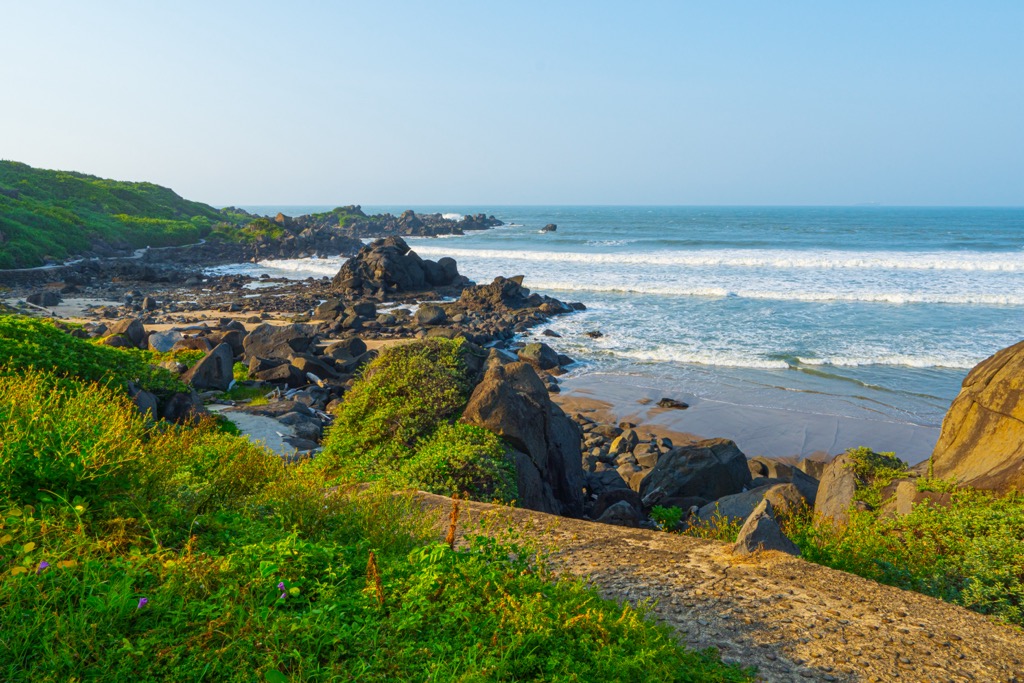
Linshanbi Nature Reserve has coastal shrubbery that coastal winds whip into an asymmetrical shape. Plants such as pittosporum, perennial chrysanthemums, moon peaches, and wind lilies grow in thin soil.
Saddle vine stretches along the shores, withstanding the intense winds, while algae grow on the reef and shoreline rocks.
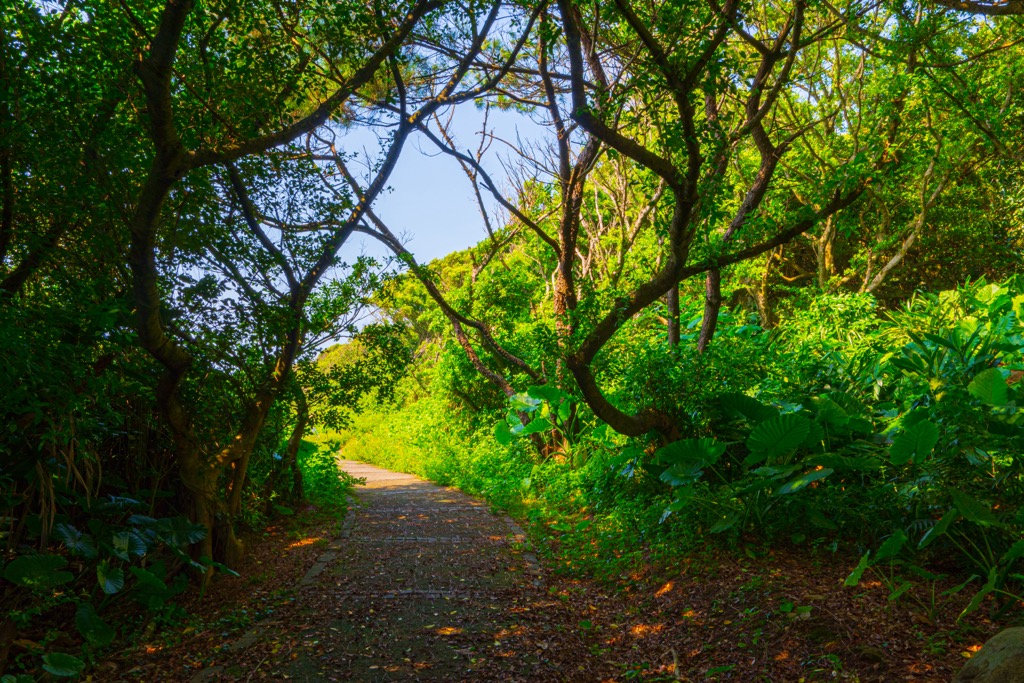
New Taipei City’s Shimen District is mostly rural, with farmlands stretching from Yangminshan National Park’s wild territory towards the north coast.
As Han Chinese settlers migrated to Taiwan in the 1600s, they arrived in Tamsui, a nearby port. They soon ventured inland and established farming communities in Shimen County’s fertile lands. Sweet potatoes and tea are the main farming produce of this region.
While agriculture thrived in Shimen County, so did the fishing industry. Linshanbi has a fishing harbour where people catch fish to sustain their living.
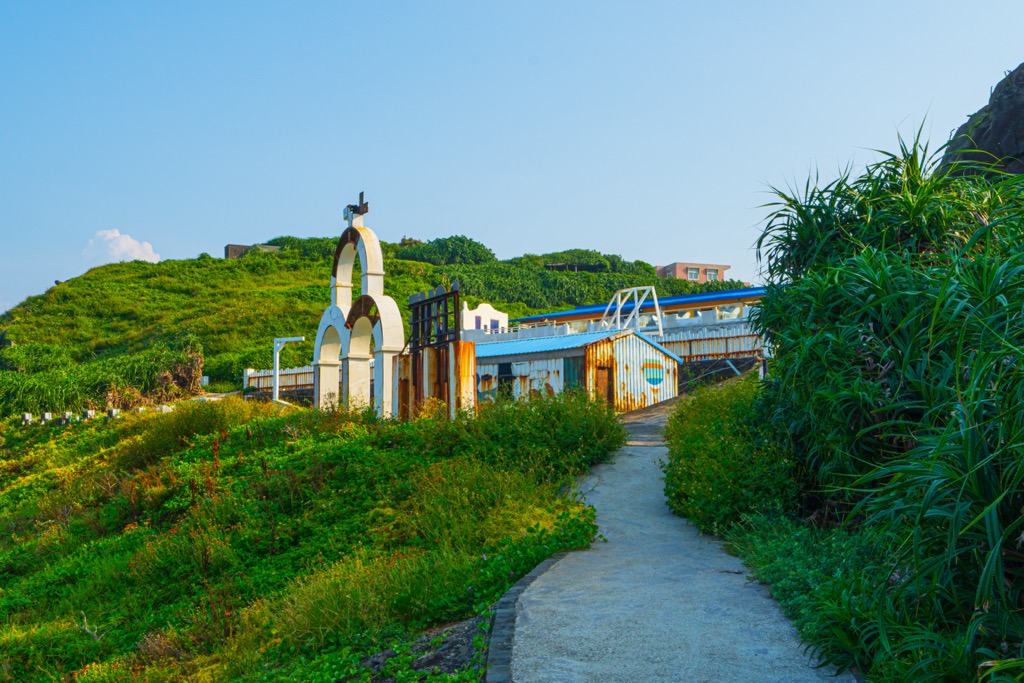
Linshanbi Nature Reserve’s major hiking trails and areas are:
Hiking Xiayuankengshan is more about the journey than climbing a mountain, as the wild vegetation obscures most prospects on this small hill. You’ll know the seashore is nearby as you can hear the blistering ocean winds and smell the salty sea air.
As you walk along the short trail to Taiwan’s northernmost hill, Xiayuankengshan, you’ll notice old and abandoned military posts. The strong sea breeze has weathered the buildings into a derelict state. Progress along the path to enter several emerald tunnels of rampant foliage. Particularly on a hot day, you’ll feel cool and refreshed in the shaded parts of the course.
As the forest ceiling disappears and you’ll feel the sun’s heat again, you’ll be surrounded by tall shrubbery that towers above you. When you reach Xiayuankengshan’s summit, you won’t see any views. However, you can descend the hill towards the cape, from where the view opens up onto the rocky reef and shores.
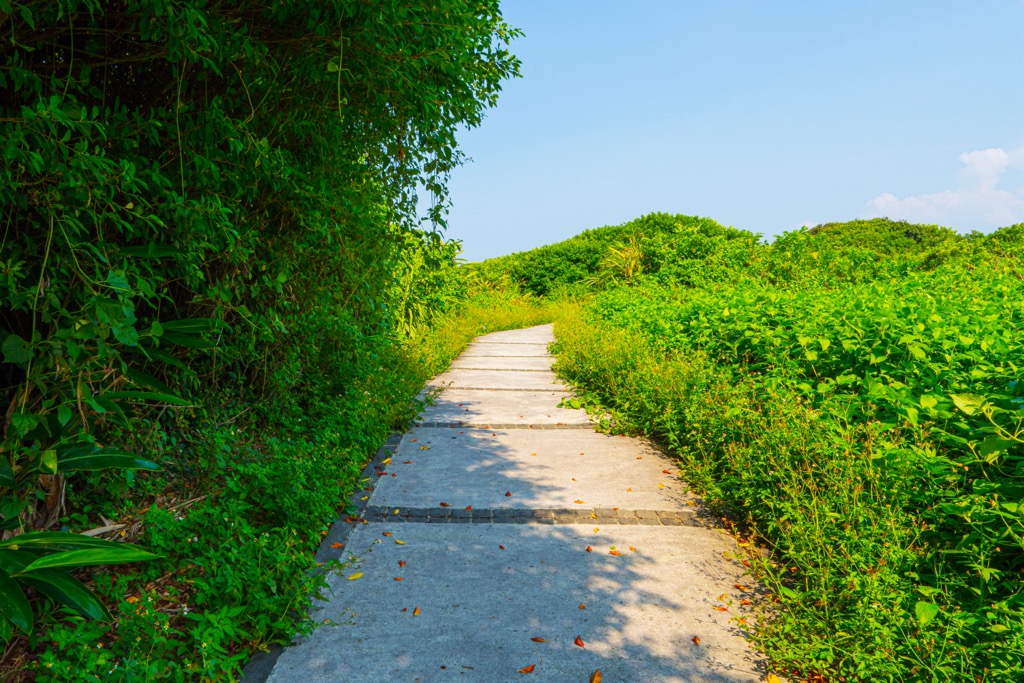
Take a stroll around Linshanbi’s peninsula to witness 4.5 km (2.8 mi) of coastal scenery. The gently rolling land with wild greenery contrasts against the sharp rocky ventifacts along the break. Seaweed and algae add texture and bottle-green shades to the ashen rocks.
Walk along the reef, where you’ll find rock pools with intertidal creatures. Look closely, and you’ll see starfish, seahorses, and barnacles on the foreshore. You may also spot oysters and shellfish and find crabs walking along the sand.
Visit in spring for a floral display of milky white lilies popping against the rampant shrubbery. You’ll also inhale their fresh aroma as the coastal winds carry their fragrance.
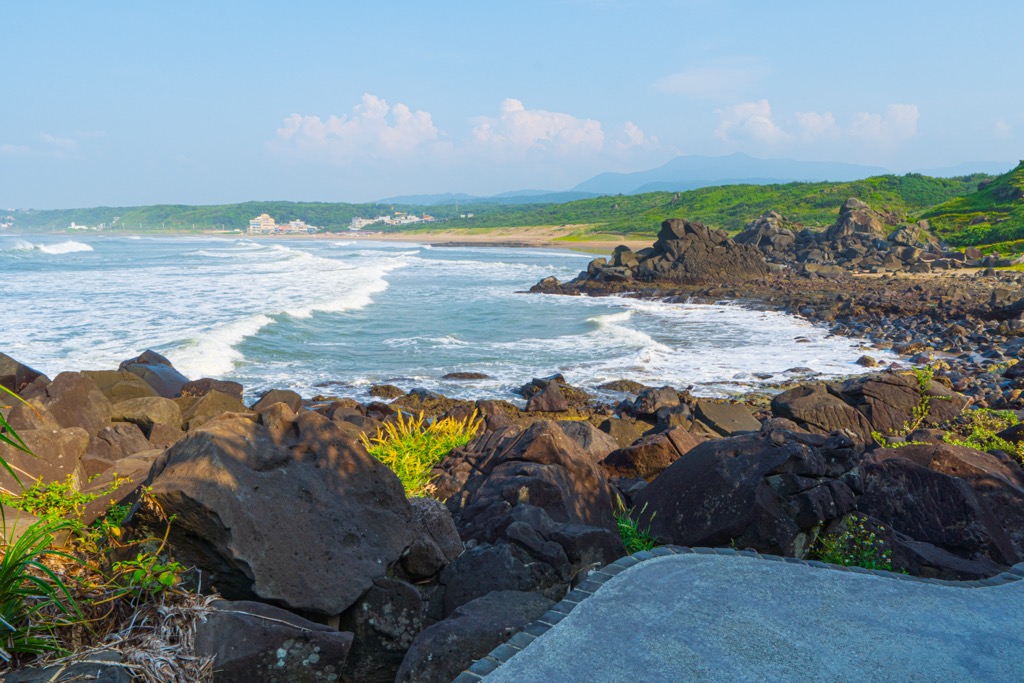
No matter what season, you’ll find deck chairs lined on Baisha Beach’s (白沙灣海水浴場) white-sand bay. Shimen locals and nearby New Taipei City residents flock to this northern Taiwan beach year-round for its scenic splendor in Taiwan’s subtropical climate.
There is plenty to do when you visit Baisha’s eroded shore. Head out for a leisurely walk along the 1 km (0.6 mi) shore and clear your thoughts to the calming sound of crashing waves. Feel the fine sand between your toes and the dampness from the high tide as you watch the sea rise and swell and inhale the fresh air.
You can also dive into the ocean, invigorating your body and awakening your senses. Then you can snorkel underwater or windsurf on the giant blue ocean.
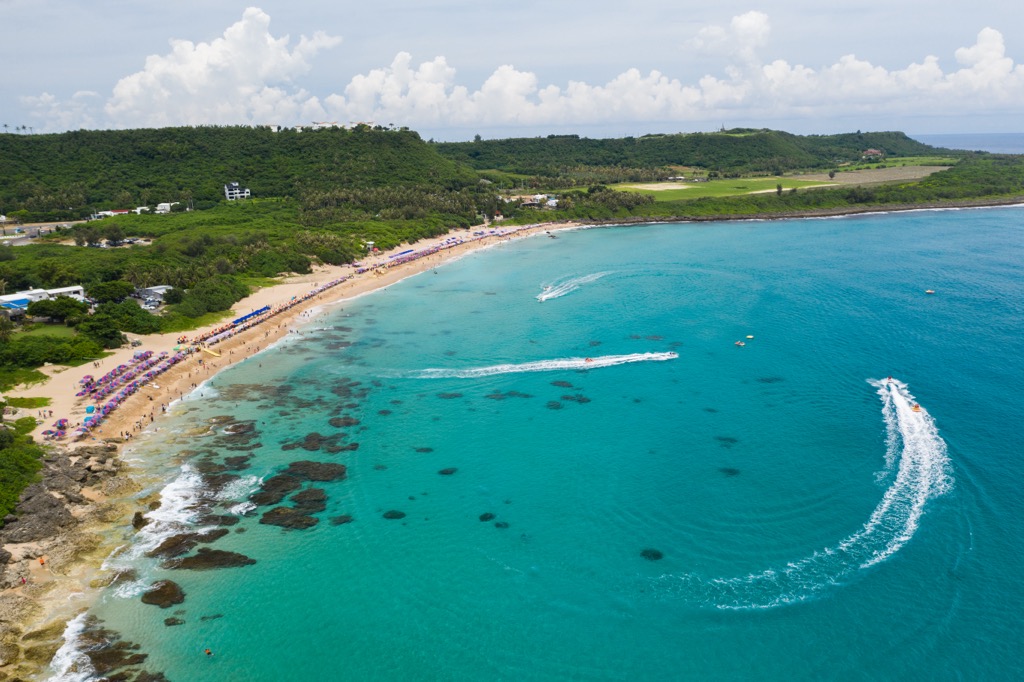
A natural wonder, Laomei Green Reef extends over Shimen’s shore in velvety rippled rows. Seeing the emerald algae's vibrant color coating the coral reef is amazing. The seaweed is at its peak between March and April, which is the best time to visit.
Explosions from the Datun Volcano Group formed Laomei's coastal magmatic reef. Over the years, the reef has grown and expanded. As the algae harden at the end of the season, a layer of limestone forms on top. Then, a new layer of algae grows on the rock layer the following year, and the process is repeated.
Many visitors come to see the enthralling emerald fuzz of Laomei Green Reef. Listen to the crashing waves combined with the howling sea winds. In the dusk light, the golden glow of the sunset tinges the sky amber.
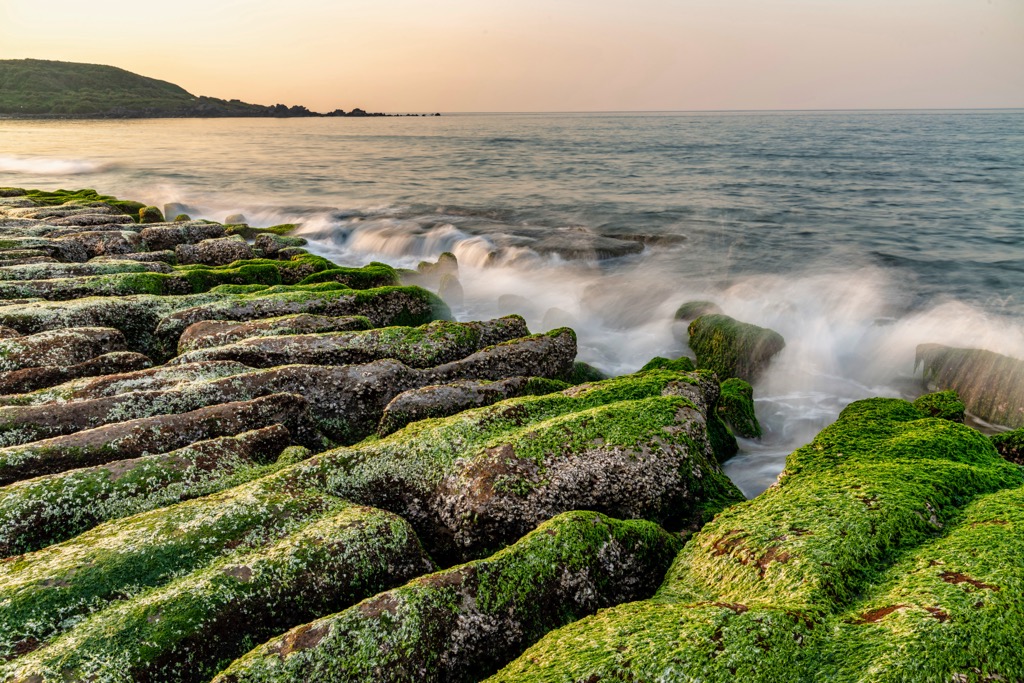
Shimendong’s (石門洞) giant stone arch was once considered Taiwan’s northernmost gate. It lies on the coast, and visitors walk through its tunnel to access the glorious white-sand beach.
This fascinating cave was created millions of years ago when the Datun volcanoes erupted. You’ll notice the mixture of interweaving volcanic debris, gravel and fine sand exposed on the surface. In springtime, the large mound erupts with lily blossoms, a beautiful and romantic embellishment on the natural stone.
A series of steps lead to the top of the cave, from where you gain an elevated vantage point of the stunning bay as foamy white waves break onto the shore. One of the best times to visit this raised level is at sunset when the burnt orange sky mirrors against the endless ocean.
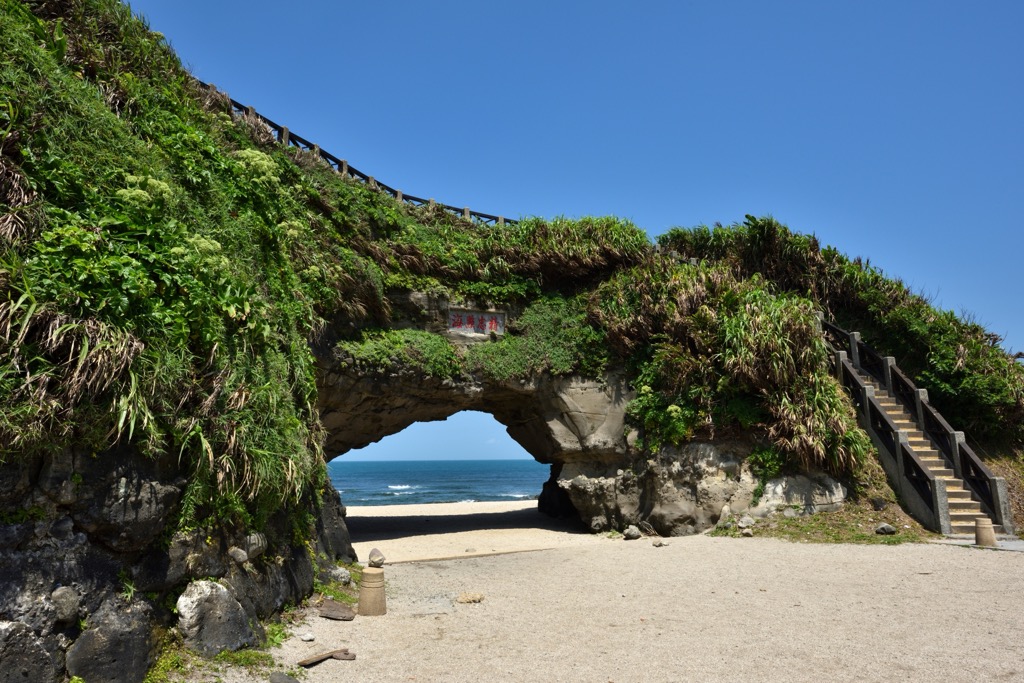
Situated south of Shimendong is the Cha Shan Tea Trail, where Shimen District’s fertile tea plantation grows. Tieguanyin tea is originally from China, but merchants brought this plant to Taiwan for its strong fragrance and deep colour. It is now favoured in Taiwan for its unique, sharp taste.
Cha Shan’s (茶山) tea fields are shielded by northern Taiwan’s coastal hills, so the coastal winds don’t interfere with the tea’s growth. Not only is it a fascinating place to visit to sample the fresh teas, but the scenery of layered tea rows is picturesque. While you’re climbing the small Cha Shan hill, you’ll be able to admire the flourishing tea plantation and surrounding mountains, lakes, and scenery.
Northern Taiwan is a treasure trove of wonderful places. When visiting Linshanbi Nature Reserve, New Taipei City’s enthralling Tamsui District lies west of Shimen District, a short drive from the northern peninsula. You can also opt to stay in Taiwan’s fascinating capital, Taipei, situated south of Shimen District.
Revisit history in Tamsui, where many Han settlers first stepped foot in Taiwan. Known for its bustling port, Tamsui has many significant landmarks and ancient structures that show its prominent past.

You can’t come to Tamsui without visiting the Fisherman’s Wharf (淡水漁人碼頭). An exciting blend of old and new, this port received a fresh revamp to celebrate its industrious past. Take a stroll along the pier to view the turquoise riverport with rows of fishing boats. You can hop on a boat ride down the river and head under the striking Lovers Bridge. In the evening, stop on the bridge to admire the glorious sunset and then head to one of the excellent seafood restaurants for a flavorsome feast.
Another popular and adventurous thing to do in Tamsui is to climb Datunshan (大屯山). Situated in Yangmingshan National Park, Datunshan Hiking Trail leads you across a series of peaks. On your journey, you’ll have incredible views of Yangmingshan National Park’s hilly landscape and Taipei’s city bowl. Another spot to cherish the glowing sunset, many people climb Datunshan’s hill to watch the golden hour infuse its peaceful glow across northern Taiwan.
Finally, another one of Tamsui’s marvels is Wuji Tian Yuan Temple (淡水無極天元宮). Visit during springtime for the romantic infusion of pastel pink cherry blossom blooms. The scenery is spectacular, with Yangmingshan National Park’s rolling hills in the background of the five-tiered Taoist pagoda. Walk on the scenic pathways around the enchanting grounds to view Wuji Tian Yuan Temple’s enchanting structure from differing angles.
There is a reason why most people flock to Taiwan’s capital city. Brimming with history and culture and surrounded by hills and leafy nature, Taipei is a beautiful place. While it's a large city, it's easily navigable and doesn’t take too long to venture from one end to another.
The first on your list of things to do in Taipei is to climb Elephant Mountain (象山). You’ll begin to understand Taipei’s subtropical climate as you encounter lush foliage when ascending the hill. A series of 600 steps lead you to the observation deck, where you’ll be amazed at what you see. You’ll look right onto Taipei 101, Taiwan’s tallest building, with Taipei’s sprawling cityscape behind it. You’ll appreciate the city’s green lungs with its many parks adding greenery to the scene.

For another view of Taipei’s verdant land, ride on the Maokong Gondola. Situated south of Elephant Mountain, you’ll see a different perspective of the capital. As you journey to Maokong (貓空), you’ll notice ravishing farmlands below. These are tea plantations where Taiwan’s famous oolong tea grows. Once you get to Maokong, walk around the mountain for mesmerizing views and stop at one of the many tea houses for a rewarding brew.
Lastly, you can’t visit Taipei without heading to a night market. Shilin Night Market (士林夜市) is one of Taiwan’s most famous and largest night markets. While it's fun to try some unique Taiwan food, like stinky tofu, coffin bread, and oyster omelets, soak up the festive atmosphere of this fascinating fanfare with its bright lights and jolly crowds.
To get to Linshanbi Nature Reserve, start your journey in Taipei. Take the Taipei MRT to Tamsui MRT Station. Then, board the North Coast Shuttle Bus or the Taipei 716 Bus and alight at the Baisha Bay stop. It is a short walk towards Linshanbi Nature Reserve.
Alternatively, you can drive 42 km (26 mi) from Taipei to Linshanbi Nature Reserve.
Explore Linshanbi Nature Reserve with the PeakVisor 3D Map and identify its summits.








